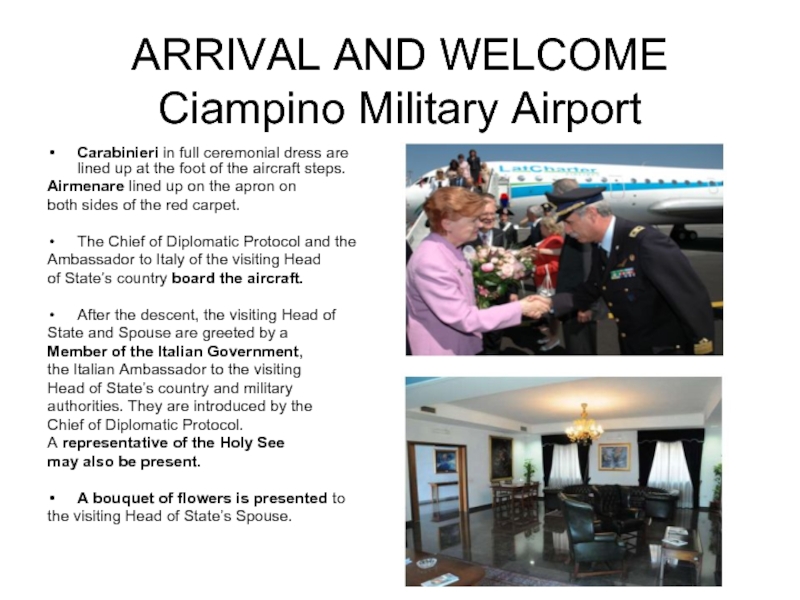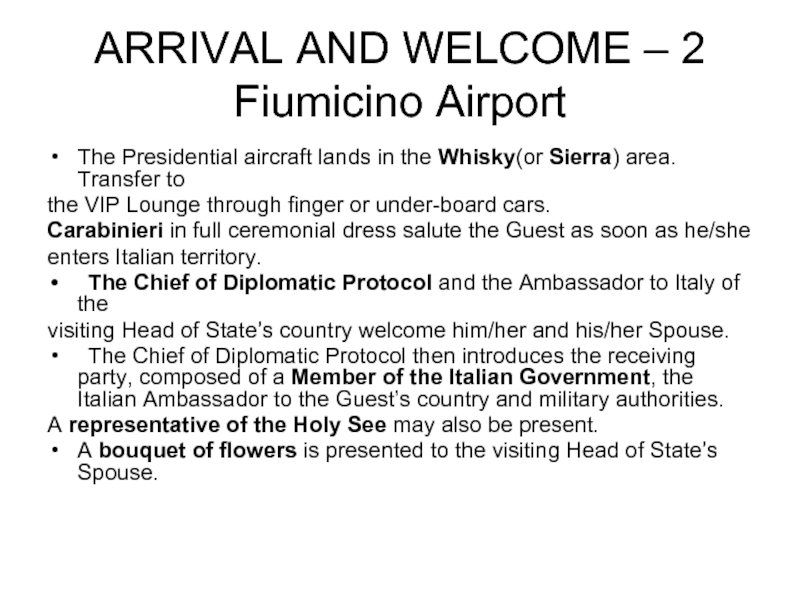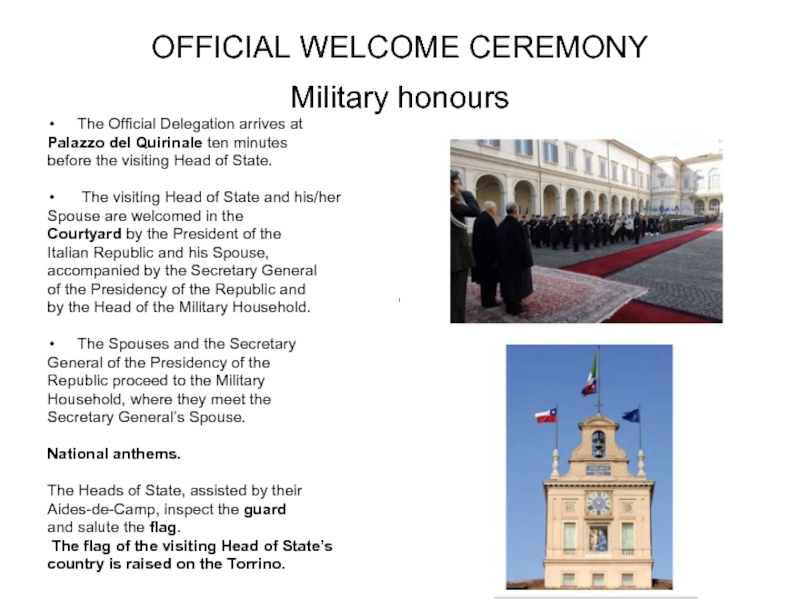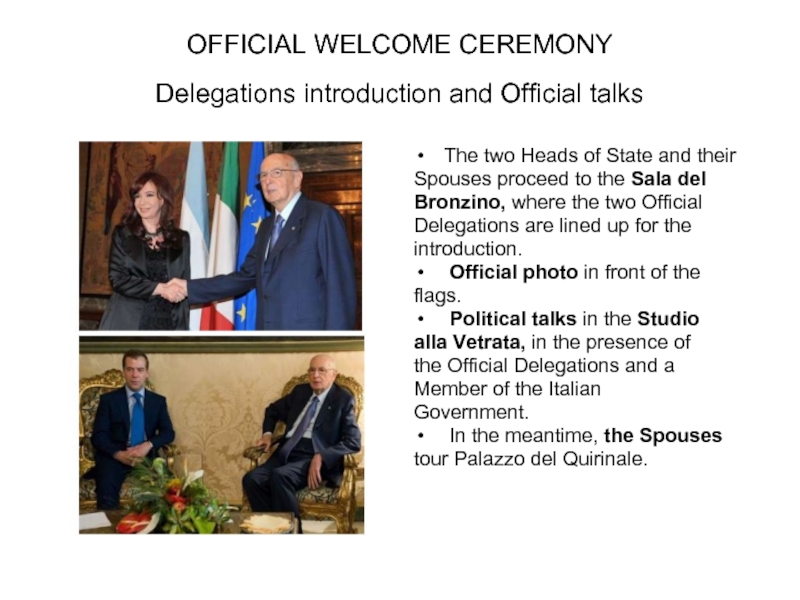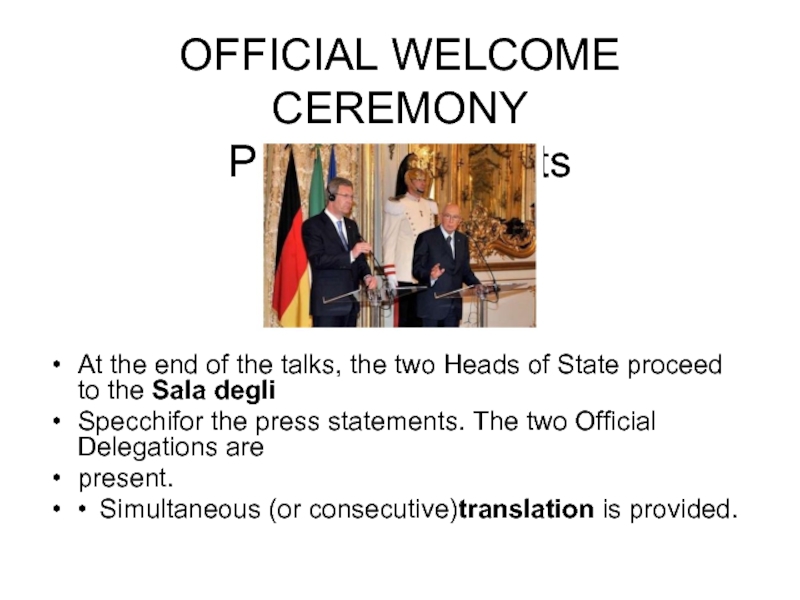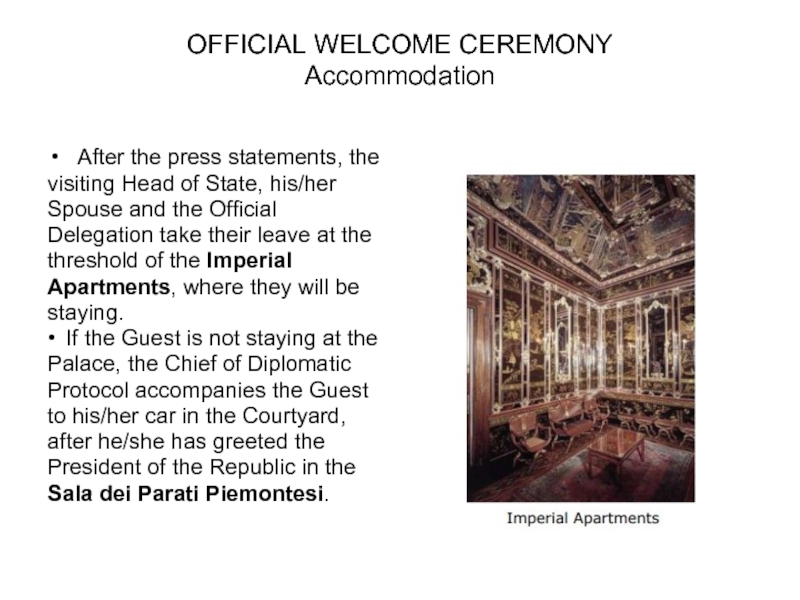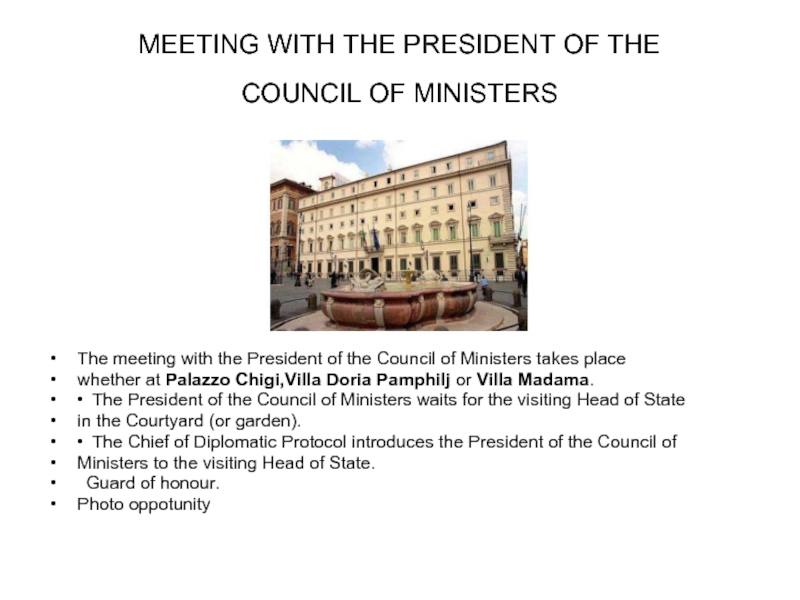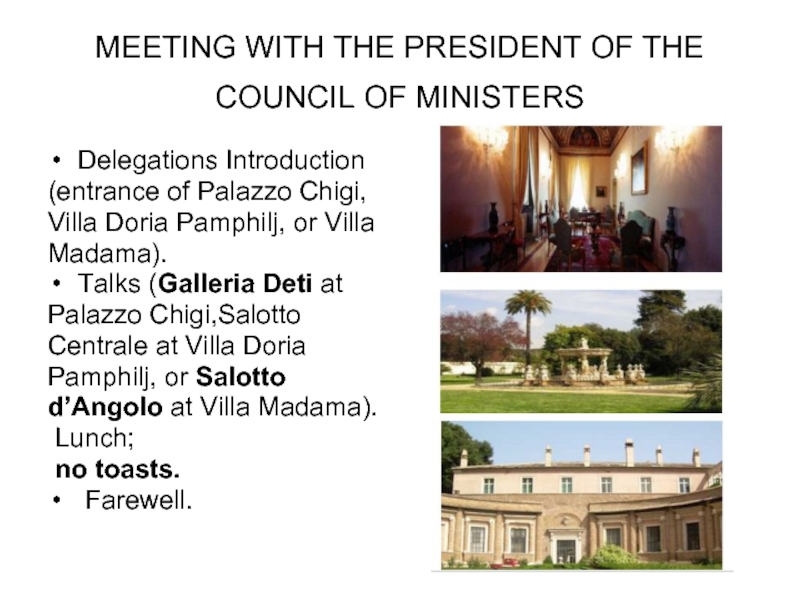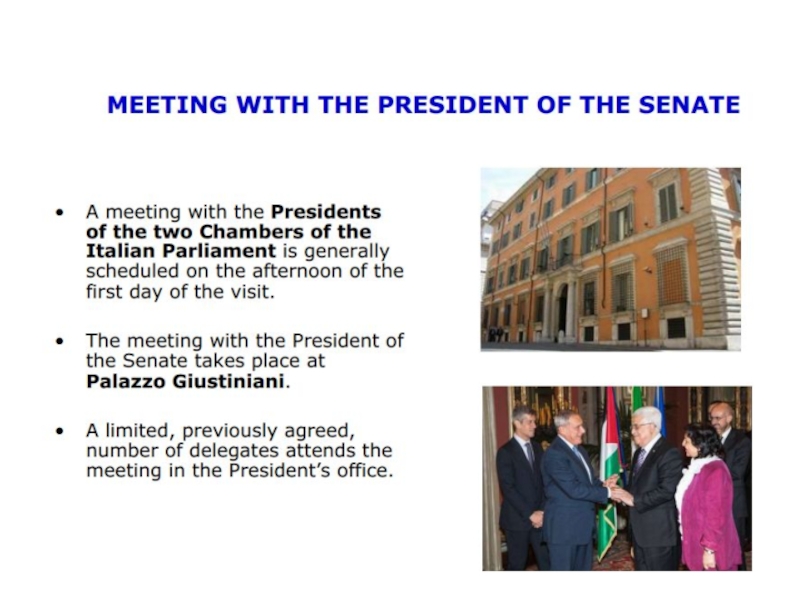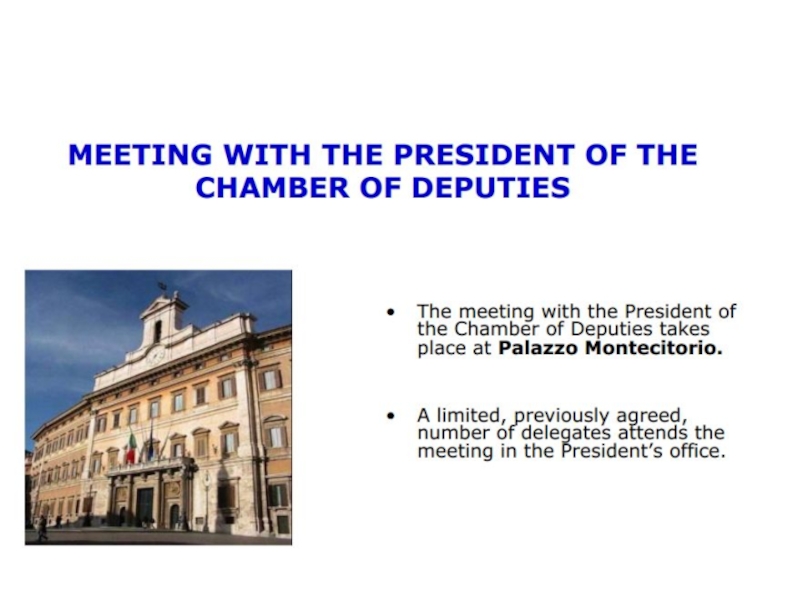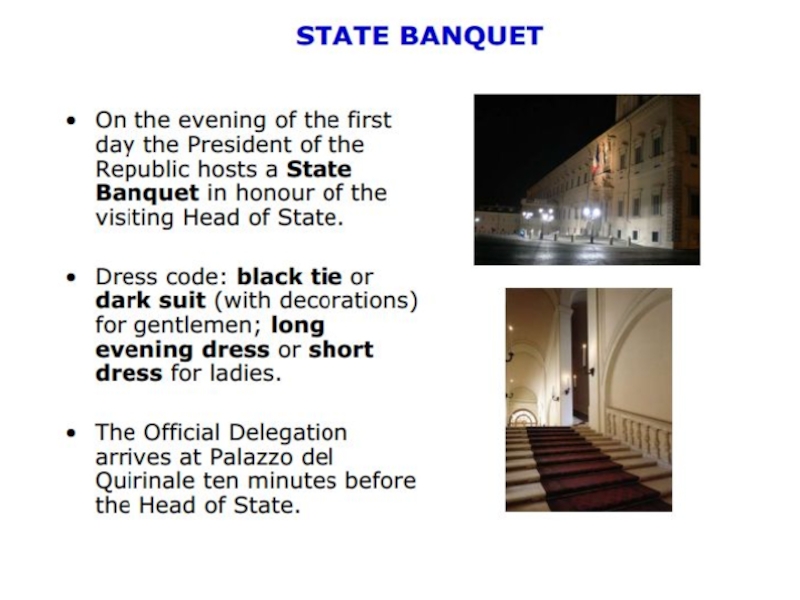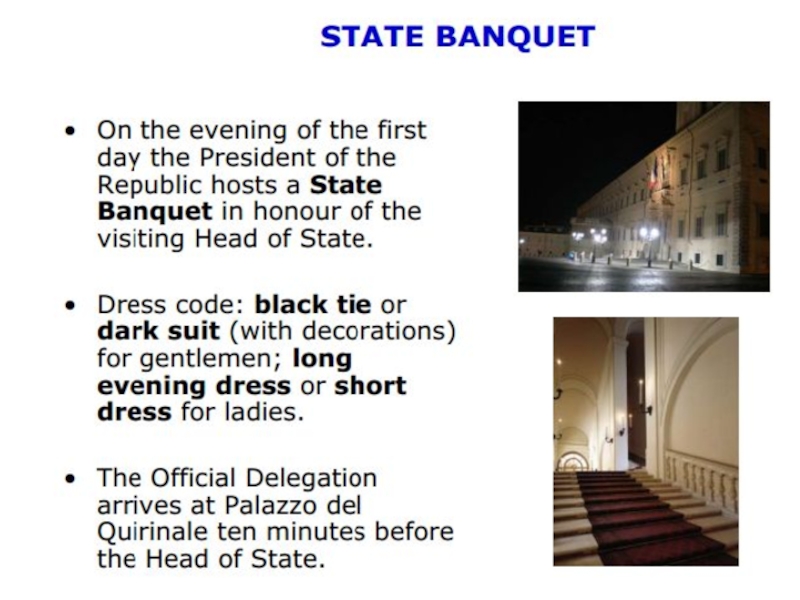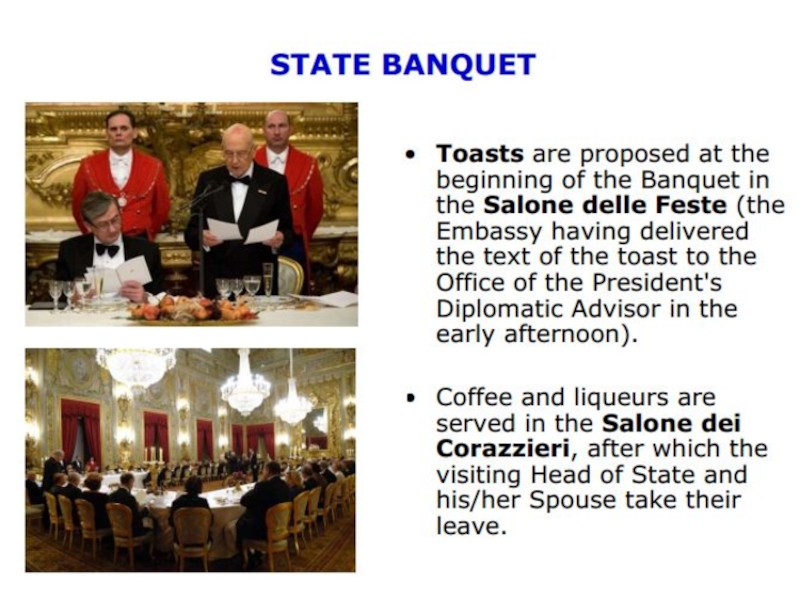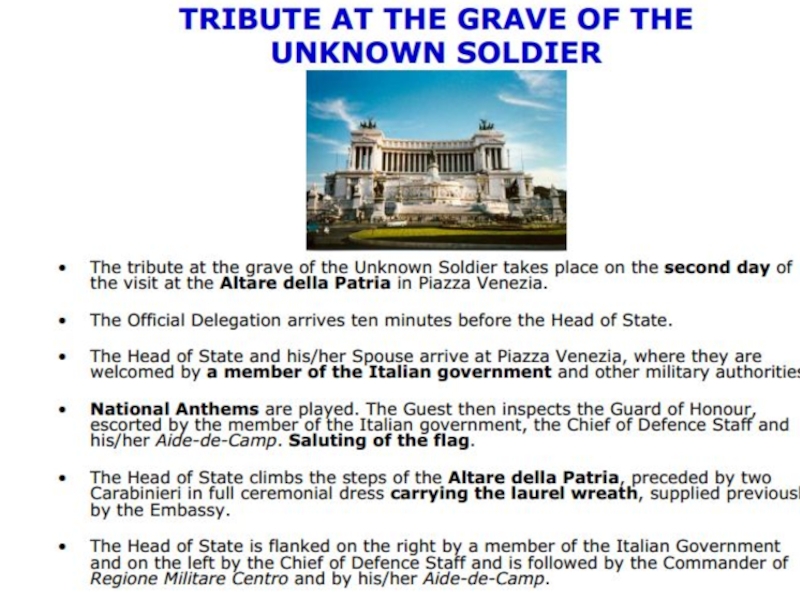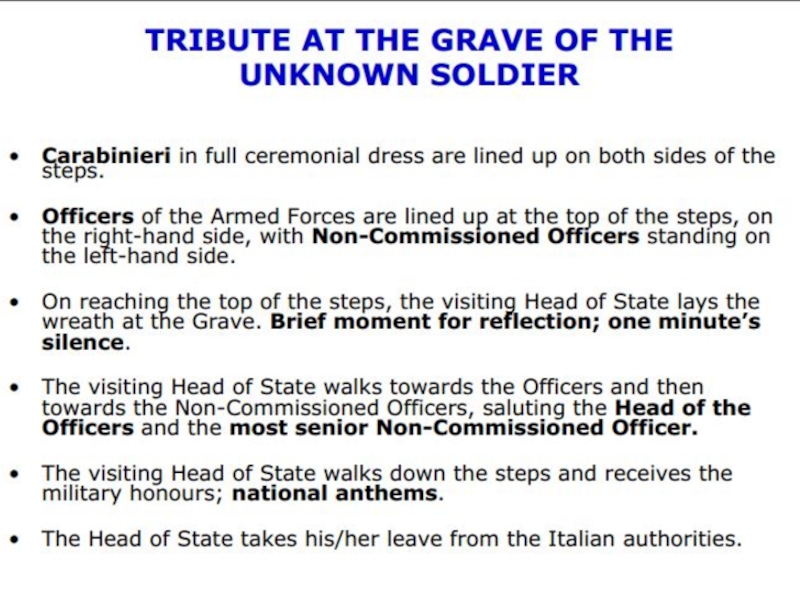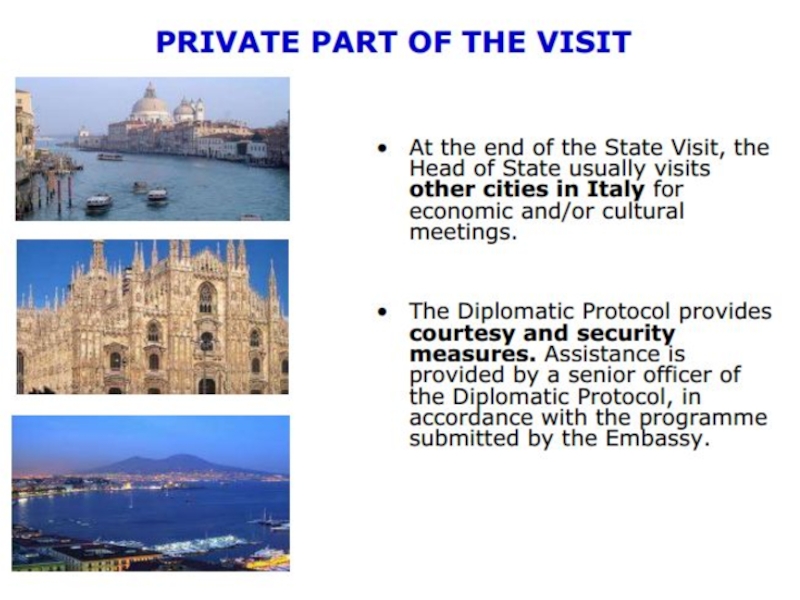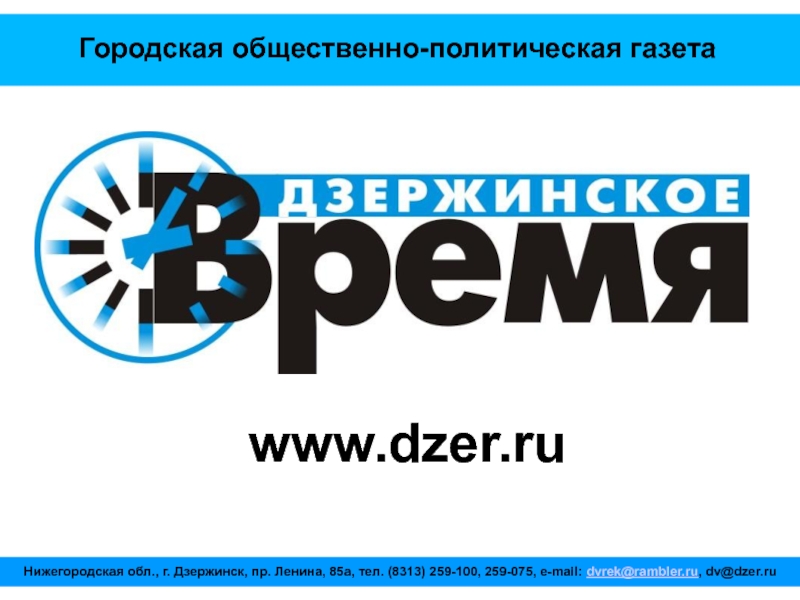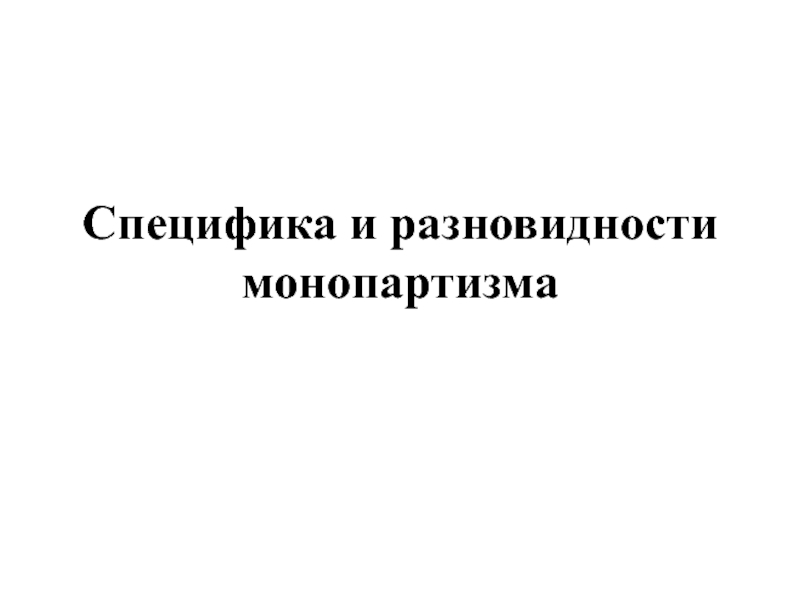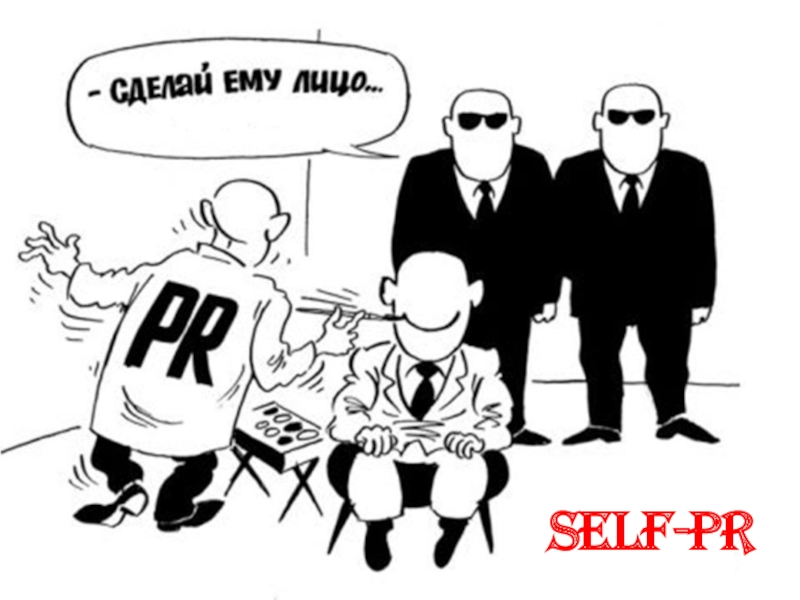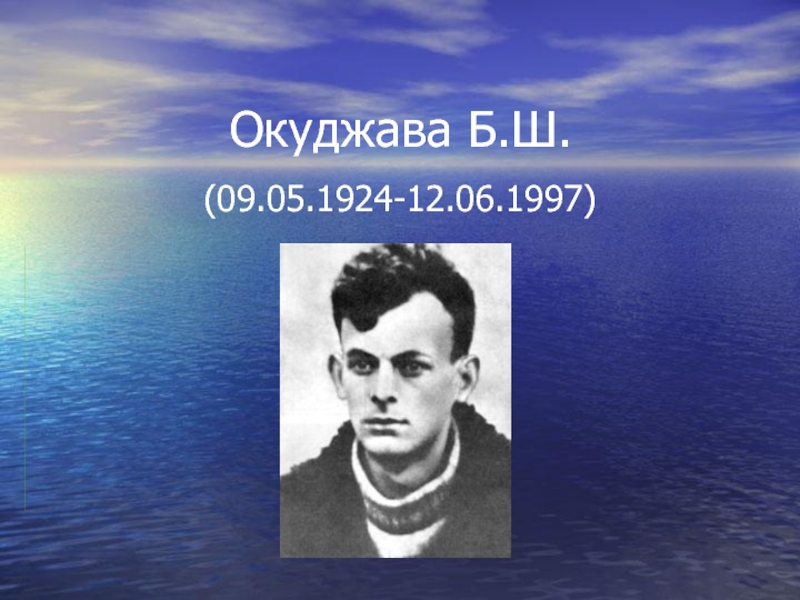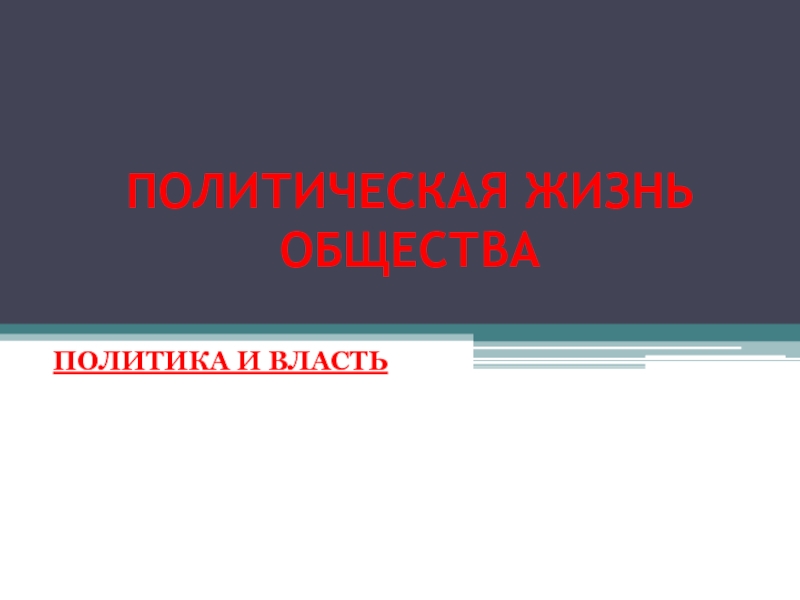- Главная
- Разное
- Дизайн
- Бизнес и предпринимательство
- Аналитика
- Образование
- Развлечения
- Красота и здоровье
- Финансы
- Государство
- Путешествия
- Спорт
- Недвижимость
- Армия
- Графика
- Культурология
- Еда и кулинария
- Лингвистика
- Английский язык
- Астрономия
- Алгебра
- Биология
- География
- Детские презентации
- Информатика
- История
- Литература
- Маркетинг
- Математика
- Медицина
- Менеджмент
- Музыка
- МХК
- Немецкий язык
- ОБЖ
- Обществознание
- Окружающий мир
- Педагогика
- Русский язык
- Технология
- Физика
- Философия
- Химия
- Шаблоны, картинки для презентаций
- Экология
- Экономика
- Юриспруденция
Organization of the Diplomatic protocol in Italy презентация
Содержание
- 1. Organization of the Diplomatic protocol in Italy
- 2. Diplomatic Protocol Proper knowledge of Protocol
- 3. Coat of arms The emblem of Italy (Italian: emblema della
- 4. The flag of Italy (bandiera d'Italia, often referred
- 5. ARRIVAL AND WELCOME Ciampino Military Airport
- 6. ARRIVAL AND WELCOME – 2 Fiumicino
- 7. OFFICIAL WELCOME CEREMONY Military honours
- 8. OFFICIAL WELCOME CEREMONY Delegations introduction and Official
- 9. OFFICIAL WELCOME CEREMONY Press statements At the
- 10. OFFICIAL WELCOME CEREMONY Accommodation After the
- 11. MEETING WITH THE PRESIDENT OF THE
- 12. MEETING WITH THE PRESIDENT OF THE
Слайд 2Diplomatic Protocol
Proper knowledge of Protocol is essential for large corporation’s executives
and government officials to interact with each other. Respect, courtesy and diplomacy are the main principals. It is a means by which people of all cultures can relate to each other. You must not offend or embarrass an individual or country. Knowledge and awareness of Protocol and verbal diplomacy is a must during formal events and creates a professional image.
Слайд 3Coat of arms
The emblem of Italy (Italian: emblema della Repubblica Italiana) was formally adopted
by the newly formed Italian Republic) was formally adopted by the newly formed Italian Republic on 5 May 1948. Although often referred to as a coat of arms (or stemma in Italian), it is technically an emblem in Italian), it is technically an emblem as it was not designed to conform to traditional heraldic in Italian), it is technically an emblem as it was not designed to conform to traditional heraldic rules. The emblem comprises a white five-pointed star in Italian), it is technically an emblem as it was not designed to conform to traditional heraldic rules. The emblem comprises a white five-pointed star, with a thin red border, superimposed upon a five-spoked cogwheel in Italian), it is technically an emblem as it was not designed to conform to traditional heraldic rules. The emblem comprises a white five-pointed star, with a thin red border, superimposed upon a five-spoked cogwheel, standing between an olive in Italian), it is technically an emblem as it was not designed to conform to traditional heraldic rules. The emblem comprises a white five-pointed star, with a thin red border, superimposed upon a five-spoked cogwheel, standing between an olive branch to the dexter side and an oak in Italian), it is technically an emblem as it was not designed to conform to traditional heraldic rules. The emblem comprises a white five-pointed star, with a thin red border, superimposed upon a five-spoked cogwheel, standing between an olive branch to the dexter side and an oak branch to the sinister side; the branches are in turn bound together by a red ribbon with the inscription REPVBBLICA ITALIANA. The emblem is used extensively by the Italian government.
The armorial bearings of the House of SavoyThe armorial bearings of the House of Savoy, blazoned gules a cross argent, were previously in use by the former Kingdom of Italy, were previously in use by the former Kingdom of Italy; the supporters, on either side a lion rampant Or, were replaced with fasci littori (literally bundles of the lictors (literally bundles of the lictors) during the fascist era.
The armorial bearings of the House of SavoyThe armorial bearings of the House of Savoy, blazoned gules a cross argent, were previously in use by the former Kingdom of Italy, were previously in use by the former Kingdom of Italy; the supporters, on either side a lion rampant Or, were replaced with fasci littori (literally bundles of the lictors (literally bundles of the lictors) during the fascist era.
Слайд 4
The flag of Italy (bandiera d'Italia, often referred to in Italian as il Tricolore [il trikoˈloːre]) is
a tricolour [il trikoˈloːre]) is a tricolour featuring three equally-sized vertical pales [il trikoˈloːre]) is a tricolour featuring three equally-sized vertical pales of green [il trikoˈloːre]) is a tricolour featuring three equally-sized vertical pales of green, white [il trikoˈloːre]) is a tricolour featuring three equally-sized vertical pales of green, white and red, with the green at the hoist side. Its current form has been in use since 18 June 1946 and was formally adopted on 1 January 1948.
Some have attributed particular values to the colours, and a common interpretation is that the green represents the country's plains and the hills; white, the snow-capped AlpsSome have attributed particular values to the colours, and a common interpretation is that the green represents the country's plains and the hills; white, the snow-capped Alps; and red, blood spilt in the Wars of Italian Independence and UnificationSome have attributed particular values to the colours, and a common interpretation is that the green represents the country's plains and the hills; white, the snow-capped Alps; and red, blood spilt in the Wars of Italian Independence and Unification. A more religious interpretation is that the green represents hope, the white represents faith, and the red represents charity; this references the three theological virtues.
Some have attributed particular values to the colours, and a common interpretation is that the green represents the country's plains and the hills; white, the snow-capped AlpsSome have attributed particular values to the colours, and a common interpretation is that the green represents the country's plains and the hills; white, the snow-capped Alps; and red, blood spilt in the Wars of Italian Independence and UnificationSome have attributed particular values to the colours, and a common interpretation is that the green represents the country's plains and the hills; white, the snow-capped Alps; and red, blood spilt in the Wars of Italian Independence and Unification. A more religious interpretation is that the green represents hope, the white represents faith, and the red represents charity; this references the three theological virtues.
Слайд 5ARRIVAL AND WELCOME
Ciampino Military Airport
Carabinieri in full ceremonial dress
are lined up at the foot of the aircraft steps.
Airmenare lined up on the apron on
both sides of the red carpet.
The Chief of Diplomatic Protocol and the
Ambassador to Italy of the visiting Head
of State’s country board the aircraft.
After the descent, the visiting Head of
State and Spouse are greeted by a
Member of the Italian Government,
the Italian Ambassador to the visiting
Head of State’s country and military
authorities. They are introduced by the
Chief of Diplomatic Protocol.
A representative of the Holy See
may also be present.
A bouquet of flowers is presented to
the visiting Head of State’s Spouse.
Airmenare lined up on the apron on
both sides of the red carpet.
The Chief of Diplomatic Protocol and the
Ambassador to Italy of the visiting Head
of State’s country board the aircraft.
After the descent, the visiting Head of
State and Spouse are greeted by a
Member of the Italian Government,
the Italian Ambassador to the visiting
Head of State’s country and military
authorities. They are introduced by the
Chief of Diplomatic Protocol.
A representative of the Holy See
may also be present.
A bouquet of flowers is presented to
the visiting Head of State’s Spouse.
Слайд 6ARRIVAL AND WELCOME – 2
Fiumicino Airport
The Presidential aircraft lands
in the Whisky(or Sierra) area. Transfer to
the VIP Lounge through finger or under-board cars.
Carabinieri in full ceremonial dress salute the Guest as soon as he/she
enters Italian territory.
The Chief of Diplomatic Protocol and the Ambassador to Italy of the
visiting Head of State’s country welcome him/her and his/her Spouse.
The Chief of Diplomatic Protocol then introduces the receiving party, composed of a Member of the Italian Government, the Italian Ambassador to the Guest’s country and military authorities.
A representative of the Holy See may also be present.
A bouquet of flowers is presented to the visiting Head of State’s Spouse.
the VIP Lounge through finger or under-board cars.
Carabinieri in full ceremonial dress salute the Guest as soon as he/she
enters Italian territory.
The Chief of Diplomatic Protocol and the Ambassador to Italy of the
visiting Head of State’s country welcome him/her and his/her Spouse.
The Chief of Diplomatic Protocol then introduces the receiving party, composed of a Member of the Italian Government, the Italian Ambassador to the Guest’s country and military authorities.
A representative of the Holy See may also be present.
A bouquet of flowers is presented to the visiting Head of State’s Spouse.
Слайд 7OFFICIAL WELCOME CEREMONY
Military honours
The Official Delegation arrives at
Palazzo
del Quirinale ten minutes
before the visiting Head of State.
The visiting Head of State and his/her
Spouse are welcomed in the
Courtyard by the President of the
Italian Republic and his Spouse,
accompanied by the Secretary General
of the Presidency of the Republic and
by the Head of the Military Household.
The Spouses and the Secretary
General of the Presidency of the
Republic proceed to the Military
Household, where they meet the
Secretary General’s Spouse.
National anthems.
The Heads of State, assisted by their
Aides-de-Camp, inspect the guard
and salute the flag.
The flag of the visiting Head of State’s
country is raised on the Torrino.
before the visiting Head of State.
The visiting Head of State and his/her
Spouse are welcomed in the
Courtyard by the President of the
Italian Republic and his Spouse,
accompanied by the Secretary General
of the Presidency of the Republic and
by the Head of the Military Household.
The Spouses and the Secretary
General of the Presidency of the
Republic proceed to the Military
Household, where they meet the
Secretary General’s Spouse.
National anthems.
The Heads of State, assisted by their
Aides-de-Camp, inspect the guard
and salute the flag.
The flag of the visiting Head of State’s
country is raised on the Torrino.
Слайд 8OFFICIAL WELCOME CEREMONY
Delegations introduction and Official talks
The two Heads of
State and their
Spouses proceed to the Sala del
Bronzino, where the two Official
Delegations are lined up for the
introduction.
Official photo in front of the
flags.
Political talks in the Studio
alla Vetrata, in the presence of
the Official Delegations and a
Member of the Italian
Government.
In the meantime, the Spouses
tour Palazzo del Quirinale.
Spouses proceed to the Sala del
Bronzino, where the two Official
Delegations are lined up for the
introduction.
Official photo in front of the
flags.
Political talks in the Studio
alla Vetrata, in the presence of
the Official Delegations and a
Member of the Italian
Government.
In the meantime, the Spouses
tour Palazzo del Quirinale.
Слайд 9OFFICIAL WELCOME CEREMONY
Press statements
At the end of the talks, the two
Heads of State proceed to the Sala degli
Specchifor the press statements. The two Official Delegations are
present.
• Simultaneous (or consecutive)translation is provided.
Specchifor the press statements. The two Official Delegations are
present.
• Simultaneous (or consecutive)translation is provided.
Слайд 10OFFICIAL WELCOME CEREMONY
Accommodation
After the press statements, the
visiting Head of
State, his/her
Spouse and the Official
Delegation take their leave at the
threshold of the Imperial
Apartments, where they will be
staying.
• If the Guest is not staying at the
Palace, the Chief of Diplomatic
Protocol accompanies the Guest
to his/her car in the Courtyard,
after he/she has greeted the
President of the Republic in the
Sala dei Parati Piemontesi.
Spouse and the Official
Delegation take their leave at the
threshold of the Imperial
Apartments, where they will be
staying.
• If the Guest is not staying at the
Palace, the Chief of Diplomatic
Protocol accompanies the Guest
to his/her car in the Courtyard,
after he/she has greeted the
President of the Republic in the
Sala dei Parati Piemontesi.
Слайд 11MEETING WITH THE PRESIDENT OF THE
COUNCIL OF MINISTERS
The meeting
with the President of the Council of Ministers takes place
whether at Palazzo Chigi,Villa Doria Pamphilj or Villa Madama.
• The President of the Council of Ministers waits for the visiting Head of State
in the Courtyard (or garden).
• The Chief of Diplomatic Protocol introduces the President of the Council of
Ministers to the visiting Head of State.
Guard of honour.
Photo oppotunity
whether at Palazzo Chigi,Villa Doria Pamphilj or Villa Madama.
• The President of the Council of Ministers waits for the visiting Head of State
in the Courtyard (or garden).
• The Chief of Diplomatic Protocol introduces the President of the Council of
Ministers to the visiting Head of State.
Guard of honour.
Photo oppotunity
Слайд 12MEETING WITH THE PRESIDENT OF THE
COUNCIL OF MINISTERS
Delegations Introduction
(entrance of Palazzo Chigi,
Villa Doria Pamphilj, or Villa
Madama).
Talks (Galleria Deti at
Palazzo Chigi,Salotto
Centrale at Villa Doria
Pamphilj, or Salotto
d’Angolo at Villa Madama).
Lunch;
no toasts.
Farewell.
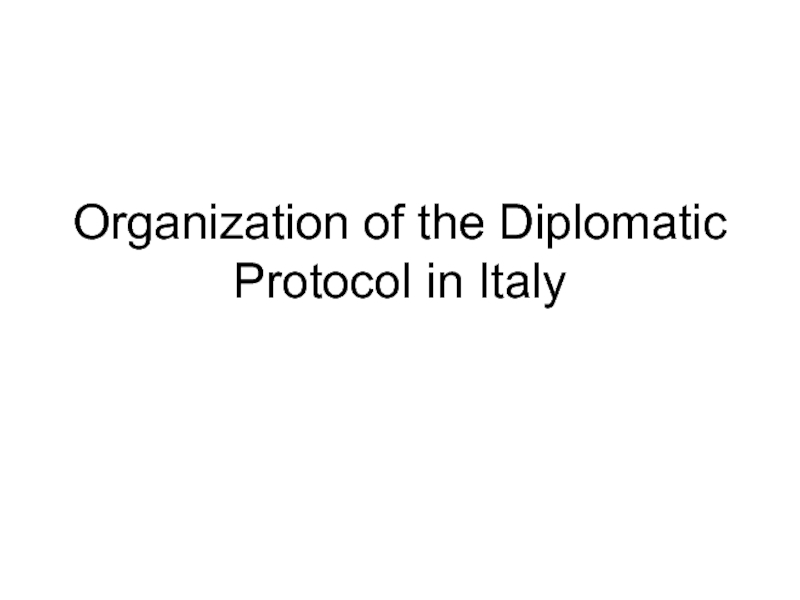
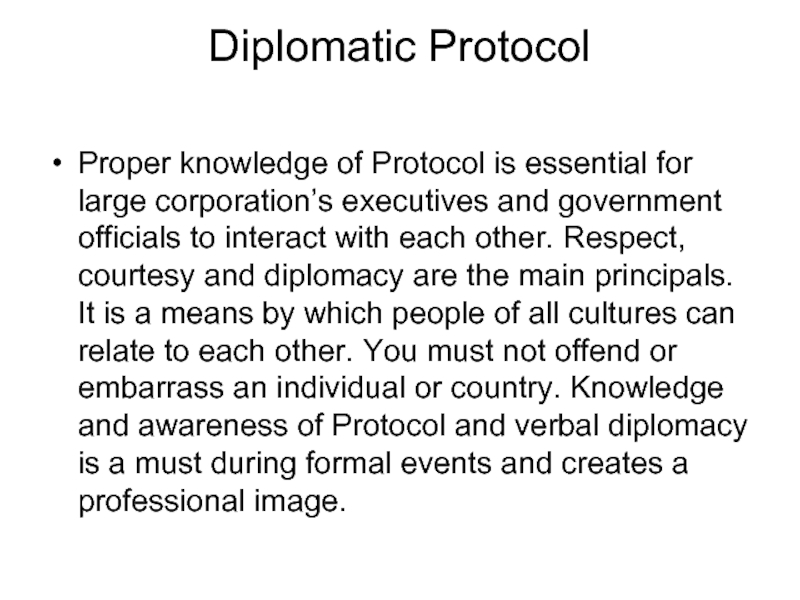
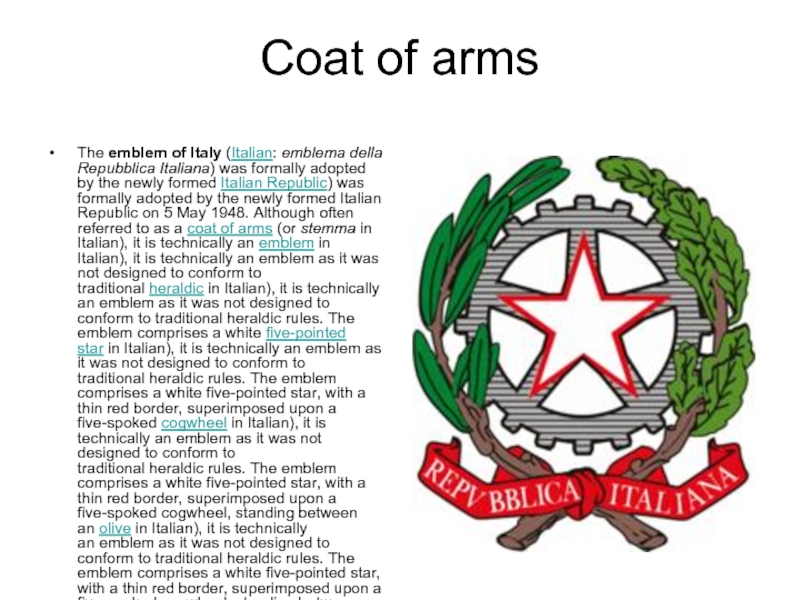
![The flag of Italy (bandiera d'Italia, often referred to in Italian as il Tricolore [il trikoˈloːre]) is a tricolour [il trikoˈloːre]) is a tricolour featuring](/img/tmb/1/35828/af70c8cd51353da98afc1dbcd45c27a1-800x.jpg)
